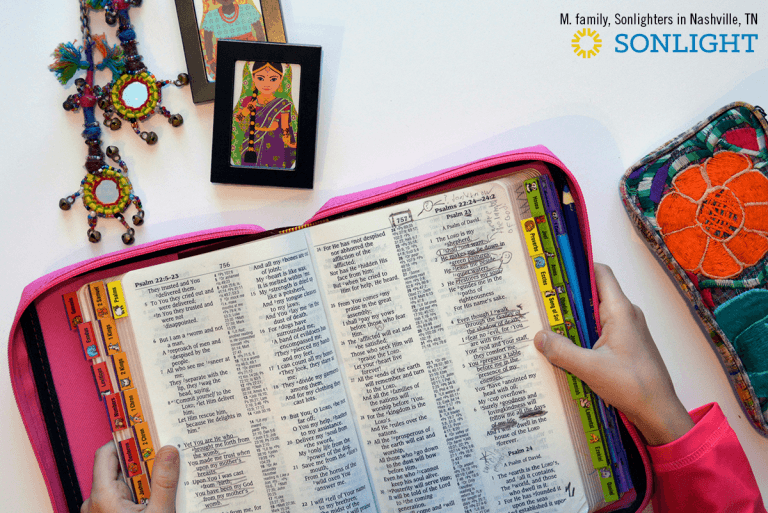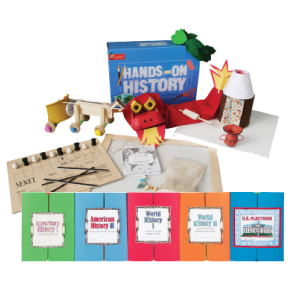Scripture extension ideas don’t have to be forced or complicated; discover fun, hands-on ways to study scripture with your children.

As Christian parents, the word of God is one of the most precious gifts we can give our children. And when we help our kids commit the word of God to memory, we’re giving them a life-affirming treasure they’ll carry always.
Deuteronomy chapter six is often quoted when it comes to raising children, isn’t it? It’s the famous monologue in which Moses admonished the Israelites to heed God’s commandments and, as the Lord instructed, “teach them diligently unto thy children.”
If you’ve been in Christian parenting circles for any length of time, you’ve likely heard this passage. In fact, you’ve probably heard it referenced more times than you can count.
God’s word is built in to Sonlight. It’s right there in the HBL acronym used to describe each level: History, Bible, and Literature. For each level, Sonlight has thoughtfully and carefully curated a selection of Scripture to read or memorize (or both) each day. These references are neatly organized at the top of each daily schedule page—already laid out for you!
In fact, using History / Bible / Literature C as an example, over the course of a school year you and your children will
- listen to more than 180 passages of Scripture,
- memorize 36 passages, and
- learn to sing a number of them, too.
That’s all without even looking outside of your big blue binder!
Interaction with Scripture is Intended to be More than Static Reading
Referring back to the “teach them diligently” passage in Deuteronomy, what does it really mean? The Message translation revives the familiar words anew, and challenges us,
“Write these commandments that I’ve given you today on your hearts.
Get them inside of you and then get them inside your children.
Talk about them wherever you are,
sitting at home or walking in the street;
talk about them from the time you get up in the morning
to when you fall into bed at night.
Tie them on your hands and foreheads as a reminder;
inscribe them on the doorposts of your homes and on your city gates.”
As I read through this again, I’m struck by how active this command is. When we break it down, we see action words:
- write
- talk
- walk
- inscribe
We already know God intends our relationship with him to permeate every area of our lives. And reading through this passage, we also clearly see He expects our interaction with the Scripture to be so much more than reading a few verses daily.
Practical Ways to Make Scripture Instruction More Active
Idealism aside, we all know life happens. How can we carry out God’s instruction to write his commandments on our hearts, in the midst of our nitty-gritty daily life? How does this work in the midst of math worksheets and dinner preparations and laundry chores? How can we, as Sonlighters, incorporate this commandment into our daily habits?
To begin, let’s look at some practical ways to take those Bible verses and make Scripture study an active, integrated, and hands-on process for your kids. (And remember, these suggestions are entirely optional. If you’re content with your current approach, don’t let this cause you to second-guess your decision. But if you’re looking for enrichment and extension ideas, keep reading!)
1. Act Out Scripture Passages Dramatically
Sonlighter Anne G. shares that she and her children sometimes “act out stories as appropriate.” These expressions can be as simple as your schedule—and the age of your children—allows; they needn’t be enormously complex. In fact, the added challenge of an improvised scene within a given time limit can be very effective! When I chatted with other Sonlighters about extending Bible instruction, dramatic interpretation was the most popular response. An added bonus? Acting appeals to high schoolers and preschoolers alike!
2. Present a Puppet Show
“My kids like to create puppet shows,” shares Maureen T. If you have young children who enjoy crafty, hands-on projects, this is a terrific idea. Work with your kids to create a set of versatile puppets to be used throughout the year, then use them to bring Bible stories to life. But depending on the ages of the your kids, encourage them to man the puppets and provide the voices themselves. They’ll learn more by figuring out how to express what the passage is saying than by simply watching you.
3. Illustrate and Hand-Letter a Portfolio
I’ve written previously on encouraging your child in handwriting and penmanship. Genesis 49 and Exodus 25 remind us God gives everyone different gifts. Some are more artistic than others. That’s okay! If copywork isn’t your child’s favorite, then skip this extension idea. But if you have artists and scribes itching to hone their craft, allow them to select a few sentences of Scripture each day to render artistically into a bound book. No matter the ages of your kids, Sonlighter Maya M. agrees a portfolio like this “will be so sweet to look back on later.” It’s also a great time to:
- practice art techniques,
- incorporate music appreciation, or even
- pull out a fountain pen or quill!
4. Create an Animated Flip Book
Bring stick figures—and Bible passages—to life with some quick sketching skills! Maureen T. lets us take a peek into her own home, sharing, “My kids are really into making flip books to retell a story—or a stick figure stop-motion movie.” She warns, though, to cap the drawing at five or ten minutes, to keep the project from sabotaging your schedule.
5. Record Voice Memos
My daughter really enjoys using the voice memo app on my phone to clearly read Scripture selections and poetry snippets. Listening to the audio playback offers the added benefit of reinforcing what she’s read, which aids in memorization, too. (In fact, when polishing memory work, we use the voice memo app to record recitations.) And recording in a cozy spot in the house also provides a no-pressure environment for working on enunciation and articulation.
Rest in the Promises of God; His Word Will Not Return Empty
There are countless other ways to dynamically incorporate the Scriptures into your homeschool:
- Recreate a Bible scene with LEGO bricks.
- Let your children write, highlight, and underline in their Bibles.
- Encourage margin doodles.
- Take turns reading aloud. Use expression and dramatic voices!
- Listen to Scripture set to music.
- Journal brief thoughts on what the passages mean.
- Sculpt Biblical characters in clay.
- Play charades to review the week’s readings.
- Pause while reading aloud to allow your kids to add sound effects.
- Write a newspaper account of a Bible story.
- Cook an ancient meal for dinner.
- Look up unknown words—a concordance is terrific for diving into word history.
- Read through the Scripture passage again. Can any part of it be classified as a prayer?
- Get a wall calendar with a generous amount of room to write, and jot down a short note about each passage in the corresponding day’s square.
- If you’re pursuing foreign language study, read the section in your target language—lots of parallel Bible tools are available online.
Scripture extension ideas don’t have to be forced or complicated; simply live authentically and talk often with your kids about what you’ve read together. And actively model the habit of reading the Bible; kids watch what you do as well as listen to what you say.
Be encouraged, fellow warriors. God’s word is powerful. Rest in the promise of Isaiah 55:11,
“So will My word be which goes forth from My mouth;
It will not return to Me empty,
Without accomplishing what I desire,
And without succeeding in the matter for which I sent it.”

To find out more about Sonlight's unmatched Read-Alouds, and our complete book-based homeschool programs, order a complimentary copy of your catalog today.







